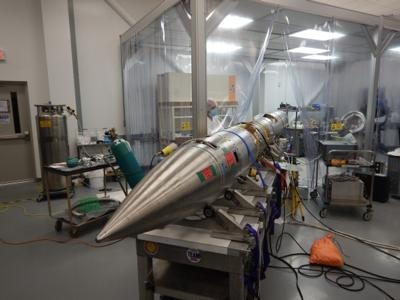Tue, Nov 04, 2014
Mission Planned For Early November From White Sands In New Mexico
A sounding rocket outfitted with technology to gather 1,500 images of the sun over its five-minute mission is preparing to launch in early November 2014. Capturing five images per second, the RAISE mission will focus in on the split-second changes that occur near active regions on the sun – areas of intense and complex magnetic fields that can give birth to giant eruptions on the sun that shoot energy and particles out in all directions.

"Even on a five-minute flight, there are niche areas of science we can focus on well," said Don Hassler, a solar scientist at the Southwest Research Institute in Boulder, Colorado, and Director of the Institut d’Astrophysique Spatiale in Orsay, France. "There are areas of the sun that need to be examined with the high-cadence observations we can provide."
RAISE – short for Rapid Acquisition Imaging Spectrograph Experiment – creates a kind of data product called a spectrogram, which separates the light from the sun into different wavelengths. The different wavelengths correspond to differing temperatures and velocities of the material. Therefore, analyzing the intensity of light at each wavelength gives scientists much needed information about how material is being heated and moved around on the sun.
The sun has been extremely active recently, producing several X-class flares in the past few weeks. The team will aim their instrument at one of these active regions to try to understand better the dynamics that cause these regions to erupt. By focusing in on the quick changes in this region, they hope to see how heat and energy move through such active regions, which in turn helps scientist understand what creates the regions and perhaps even what catalyzes the sun's eruptions.
Sounding rockets fly for just 15 minutes, usually providing five to six minutes of access to science that can only be accomplished from space. The extreme ultraviolet light that RAISE observes, for example, cannot pass through Earth's atmosphere to reach ground telescopes. While the flight time is short, such missions provides a low-cost access to high-quality research.
In addition, the rockets provide a test bed for new technologies. The current RAISE payload includes a new diffraction grating – coated with a new material called boron carbide – which reflects light and separates it into its separate wavelengths.
"This is the second time we have flown the RAISE payload, and we keep improving it along the way," said Hassler. "This is a technology that is maturing relatively quickly."
An instrument capable of such high-cadence observation could make its way on to future, more permanent solar observatories. It is already serving as a development platform for instruments on the joint European Space Agency-NASA Solar Orbiter Mission, which is scheduled to launch in 2017 and to go to within 26 million miles of the sun. (Mercury's closest approach to the sun is about 28.6 million miles.)
RAISE's launch time was planned for 2:07 p.m. EST on Nov. 3, 2014, from the White Sands Missile Range near Las Cruces, New Mexico. Launch timing will depend on good weather conditions as well as coordinated timing with other space observatories, such as NASA's Solar Dynamics Observatory and Interface Region Imaging Spectrograph, as well as the joint Japanese Aerospace Exploration Agency and NASA's Hinode.
(Image provided by NASA)
More News
Very High Frequency The frequency band between 30 and 300 MHz. Portions of this band, 108 to 118 MHz, are used for certain NAVAIDs; 118 to 136 MHz are used for civil air/ground voi>[...]
Aero Linx: Aviation Suppliers Association Established February 25, 1993, the Aviation Suppliers Association (ASA), based in Washington, D.C., is a not-for-profit association, repre>[...]
Have A Story That NEEDS To Be Featured On Aero-News? Here’s How To Submit A Story To Our Team Some of the greatest new stories ANN has ever covered have been submitted by our>[...]
From 2021 (YouTube Version): Colorado Campus Offers aVariety Of Aerospace Entertainment And Education Wings over the Rockies Exploration of Flight is the second location for the Wi>[...]
Also: Paramotor Champ's, Electric Ultralight, ICON BK Update, Burt Rutan at Oshkosh! The Popular Rotorcraft Association is reaching out for help in rebuilding their private runway >[...]
 ANN's Daily Aero-Term (05.17.24): Very High Frequency
ANN's Daily Aero-Term (05.17.24): Very High Frequency ANN's Daily Aero-Linx (05.17.24)
ANN's Daily Aero-Linx (05.17.24) ANN FAQ: Submit a News Story!
ANN FAQ: Submit a News Story! Classic Aero-TV: ANN Visits Wings Over The Rockies Exploration Of Flight
Classic Aero-TV: ANN Visits Wings Over The Rockies Exploration Of Flight Airborne Affordable Flyers 05.16.24: PRA Runway, Wag-Aero Sold, Young Eagles
Airborne Affordable Flyers 05.16.24: PRA Runway, Wag-Aero Sold, Young Eagles



